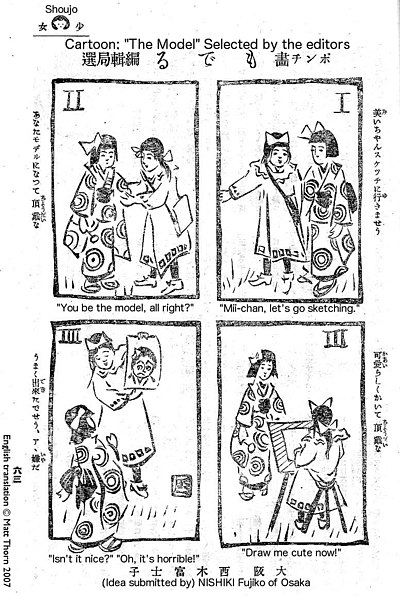
Henohenomoheji ( Japanese: へのへのもへじ HEH-noh-HEH-noh-moh-HEH-jee) or hehenonomoheji (へへののもへじ) is a face known to be drawn by Japanese schoolchildren using hiragana characters. [1] It became a popular drawing during the Edo period. [2]
Composition
The word breaks down into seven hiragana characters: he (へ), no (の), he (へ), no (の), mo (も), he (へ), and ji (じ). The first two he are the eyebrows, the two no are the eyes, the mo is a nose, and the last he is the mouth. The outline of the face is made by the character ji, its two short strokes ( dakuten) forming the ear or cheek.
Henohenomoheji is often used to symbolize a nondescript or generic human face, such as the faces of kakashi ( scarecrows) [1] and teru teru bōzu. The characters are often sung as they are drawn, making the henohenomoheji an ekaki uta (絵描き歌, drawing song). [2]
Gallery
-
As a graffito
-
On a teru teru bōzu
-
On a scarecrow
-
An early example as a detail on a netsuke from the 19th century
See also
References
- ^ a b "Let's Learn Hiragana with Japanese Culture: Henohenomoheji". Japanese.about.com. Archived from the original on 2014-08-28. Retrieved 2009-08-11.
- ^ a b Natsue, Washizu (1997). わらべうたとナーサリー・ライム (in Japanese). Banseisha. p. 28. ISBN 9784891882709.
External links
- Henohenomoheji variations at the Wayback Machine (archived May 6, 2015) (in Japanese)

Henohenomoheji ( Japanese: へのへのもへじ HEH-noh-HEH-noh-moh-HEH-jee) or hehenonomoheji (へへののもへじ) is a face known to be drawn by Japanese schoolchildren using hiragana characters. [1] It became a popular drawing during the Edo period. [2]
Composition
The word breaks down into seven hiragana characters: he (へ), no (の), he (へ), no (の), mo (も), he (へ), and ji (じ). The first two he are the eyebrows, the two no are the eyes, the mo is a nose, and the last he is the mouth. The outline of the face is made by the character ji, its two short strokes ( dakuten) forming the ear or cheek.
Henohenomoheji is often used to symbolize a nondescript or generic human face, such as the faces of kakashi ( scarecrows) [1] and teru teru bōzu. The characters are often sung as they are drawn, making the henohenomoheji an ekaki uta (絵描き歌, drawing song). [2]
Gallery
-
As a graffito
-
On a teru teru bōzu
-
On a scarecrow
-
An early example as a detail on a netsuke from the 19th century
See also
References
- ^ a b "Let's Learn Hiragana with Japanese Culture: Henohenomoheji". Japanese.about.com. Archived from the original on 2014-08-28. Retrieved 2009-08-11.
- ^ a b Natsue, Washizu (1997). わらべうたとナーサリー・ライム (in Japanese). Banseisha. p. 28. ISBN 9784891882709.
External links
- Henohenomoheji variations at the Wayback Machine (archived May 6, 2015) (in Japanese)




